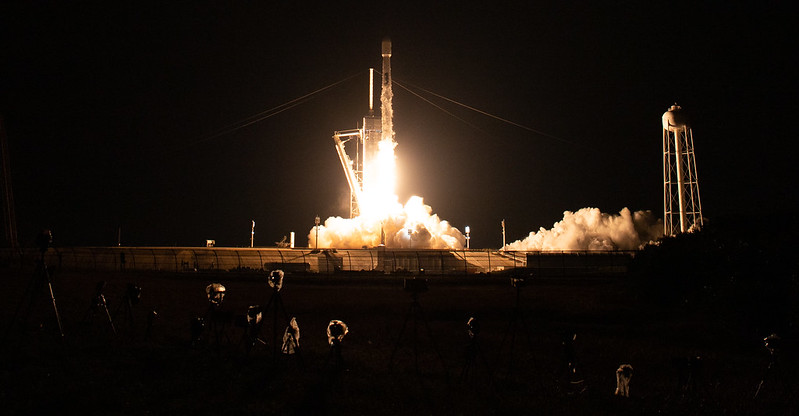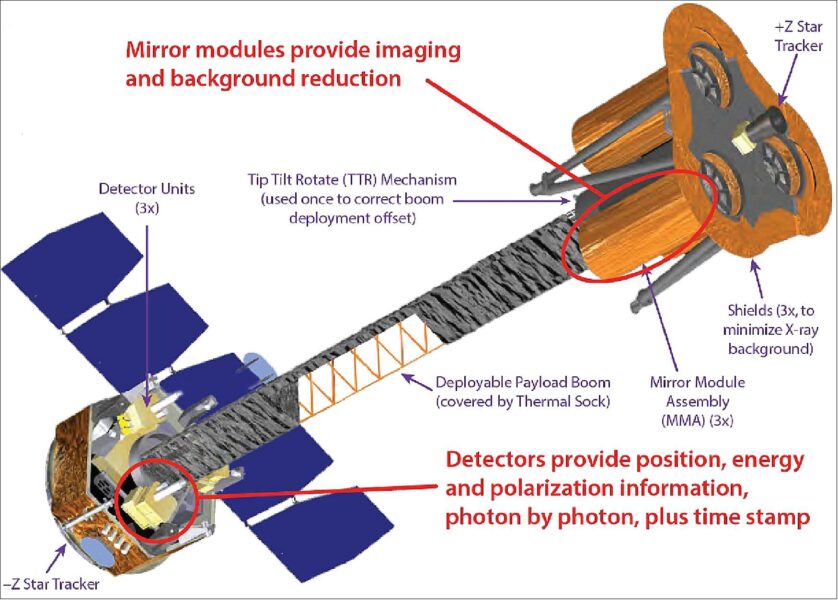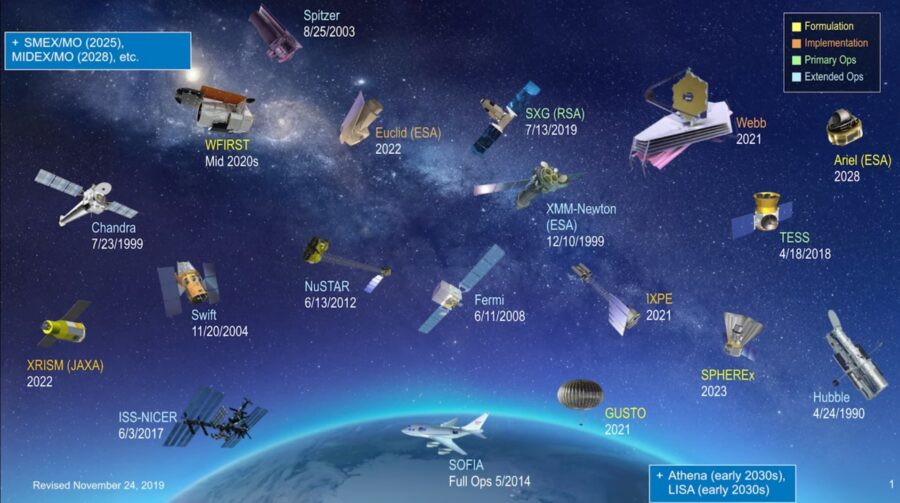
NASA / Joel Kowsky
It’s a busy month for launching astronomical observatories. While the countdown is on for the long-anticipated launch of the James Webb Space Telescope on December 22nd, NASA launched another space observatory this morning, as a SpaceX Falcon 9 rocket carried the Imaging X-ray Polarimetry Explorer (IXPE) into orbit. The launch occurred at 1 a.m. EST (6:00 UT) from Launch Pad 39A at the Kennedy Space Center in Florida.
Liftoff, Falcon Stage 1 recovery and landing, and spacecraft deployment occurred flawlessly, putting IXPE in an equatorial, low-Earth orbit. The nearly 0°-inclination orbit avoids exposure to the South Atlantic Anomaly, a region where the innermost portion of the Van Allen radiation belts nears Earth. Placing the spacecraft in such a low-inclination orbit was at the very edge of the capabilities of SpaceX’s Falcon 9 rocket, which had to perform a plane-of-inclination change, or “dogleg,” maneuver shortly after liftoff.
Solar arrays unfurled as expected one minute after spacecraft deployment. Next comes the spacecraft commissioning phase over the next week, to include boom extension. First light and the beginning of science operations for IXPE should occur in early January 2022, with an initial observation of supernova remnant Cassiopeia A.
“IXPE represents another extraordinary first,” says Thomas Zurbuchen (NASA-Science Mission Directorate) in a recent press release. “Together, with our partners in Italy and around the world, we’ve added a new space observatory to our fleet that will shape our understanding of the universe for years to come.”
IXPE is a joint collaboration between NASA and the Italian Space Agency. Part of NASA’s long-running Explorer Program, the observatory will cost $214 million from development through its primary two-year mission. IXPE is expected to begin primary science operations in January 2022.
Seeing X-rays in a New Light
X-rays originate under some of the most extreme conditions in the universe: collisions, explosions, 10-million-degree temperatures, and strong magnetic fields. IXPE will examine these processes using a largely unexplored property of X-rays, known as polarization.
Certain processes emit X-rays as electromagnetic waves that vibrate in a preferred direction. Other processes emit X-rays that vibrate every which way. By measuring the degree of polarization, IXPE will help astronomers gain insight into the structures and processes at work inside and around enigmatic astrophysical objects such as supernovae, magnetars, and feeding black holes.
Besides learning about the emission processes themselves, astronomers can also use X-ray polarization as a tool: For example, the degree of polarization of X-rays emitted from inspiraling material can tell astronomers how fast the central black hole is spinning.

IXPE Team
IXPE measures polarization using three identical telescopes that sit on an extended boom. (The boom is folded for launch but will be deployed once the mission is in orbit.) The design uses grazing-incidence optics, each set consisting of 24 nested cylindrical mirrors. Each set of mirrors focuses photons in the 2 to 8 kilo-electron volt (keV) range onto a detector. Together, the triplet of X-ray telescopes will measure four key properties of incoming photons: arrival time, direction, energy, and most importantly, polarization.
IXPE joins several X-ray observatories already in orbit, including XMM-Newton, Chandra, NuStar, and eROSITA. (Earth's atmosphere blocks X-rays, so they can only be observed from space.)

NASA
IXPE will observe 50 X-ray sources during its primary mission, including the famous Crab Nebula pulsar and Sgr A*, the supermassive black hole at the heart of our galaxy. The main science objectives are to explain how such sources emit X-rays and to test general relativity in extreme environments.
“(IXPE) offers a new toolkit for astronomy and astrophysics,” says IXPE principal investigator Martin Weisskopf (NASA/MSFC) in a pre-launch news conference. “I can’t wait to see it at work.”

Advertisement
"explorer" - Google News
December 10, 2021 at 01:35AM
https://ift.tt/3pJA8dv
NASA Launches New X-ray Explorer - Sky & Telescope - SkyandTelescope.com
"explorer" - Google News
https://ift.tt/2zIjLrm
Bagikan Berita Ini














0 Response to "NASA Launches New X-ray Explorer - Sky & Telescope - SkyandTelescope.com"
Post a Comment